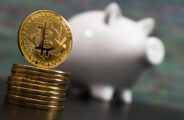2021 a boom in commodity markets [Forecasts for QXNUMX]
During 227 years of market quotations, the boom in commodity markets took place only six times. The Saxo Strats team of analysts predicts that 2021 will be the beginning of the seventh.
Commodity market with a promising forecast
The commodity bull market is a key component of the new secular inflation regime - an event that few living investors have witnessed in their careers, since the last such boom ended roughly forty years ago. Significantly, the new inflation will usher in a brutal retreat from the current euphoria in asset markets, fueled by heavily negative real rates and the easiest monetary policy in history.
About the Author
Steen Jakobsen, Chief Economist and CIO Saxo Bank. Djoined Saxo in 2000. As a CIO, he focuses on developing asset allocation strategies and analyzing the overall macroeconomic and political situation. As head of the SaxoStrats team, Saxo Bank's internal team of experts, he is responsible for all research, including quarterly forecasts, and was the founder of Saxo Bank's outrageous forecasts. Before joining Saxo Bank he cooperated with Swiss Bank Corp, Citibank, Chase Manhattan, UBS and was the global head of trade, currency and options in Christiania (currently Nordea). Jakobsen's approach to trading and investing is thought-provoking and is not afraid to oppose consensus. This often causes debate among the global market community. Every day, Jakobsen and his team conduct research in various asset classes, covering major macroeconomic changes, market movements, political events and central bank policies. With over 30 years of experience, Jakobsen regularly appears as a guest at CNBC and Bloomberg News.
In our opinion, this topic will quickly attract the attention of most investors in 2021 and this state may continue for at least the next ten years. The main factor here is the response to the pandemic, which has only accelerated the inequality trends that have grown since the 80s over the next three decades of globalization. From that point on, there will be a real paradigm shift as policy shifts away from focusing on financial stability and focusing on striving for social stability at all costs.
Financial stabilization is about maintaining liquidity in the markets and ensuring that the financial system does not hold back and is able to undertake credit expansion while limiting losses incurred in the previous cycle. Since Greenspan saved the LTCM in 1998, the political cure in each cycle has been to ease financial conditions combined with the rescue of existing assets and assets in the hope of achieving a "drip" or, as economists call it, "wealth effect". An undesirable side effect was that each cycle made the rich richer, leading to the formation of a society of rentiers and the rest, and to increasing inequality.
During the Covid-19 pandemic, these inequalities have simply become too great in the world, and while the current cycle shows similar results for the richest class to previous cycles, we are dealing with government interventions offering unprecedented support to the most disadvantaged participants in the economy, because social stabilization has now become a political priority.
Actions to maintain jobs, at least trying to prevent the bankruptcy of smaller businesses, facilitating everyday life through income support, direct transfer of funds in the form of aid checks: in the end, all of this is more or less like implementing the concept of an unconditional basic income. In response to the 2008-2009 crisis, there was an initial wave of fiscal stimulus that heralded a response to the Covid-19 crisis on a smaller scale, but unlike in the previous cycle, governments will by no means revert to the brutal austerity regime in the current cycle. after 2009, both in the United States (which contributed to Trump's victory), and in the United Kingdom (which led to Brexit) and in Europe (which caused existential tensions and a deep recession in most peripheral countries). This time around, we'll be dealing with fully Keynesian spending - perhaps even beyond anything Keynes has ever imagined - under the Modern Monetary Theory (MMT) of the idea that money is printed regardless of the debt implications, and that hot printers are in only inflation can cool down.
The social stabilization paradigm has three main goals: reducing inequality (and thus increasing demand), green transition, and improving infrastructure.
The first implication of this shift is to shift the focus to minimum income, which will lead to the implementation of more demand-side incentives, as the lowest paid tend to be able to save at most a small fraction of their income. Another government demand stimulus will be a green (green) transition that is initially unprofitable unless accompanied by massive public subsidies. In addition, infrastructure investments have been severely affected since the austerity regime following the 2008-2009 crisis, in part related to the green transition. Their list is endless and includes, for example, roads, bridges, power grids and internet infrastructure.
Inflation, inflation, inflation
Now let's move on to inflation. In the context of such a strong influence from governments, and now also from institutional money, one of the important aspects is the cost of the physical and raw materials necessary to meet the growing consumer demand and to implement large-scale investments. From food and fuel to industrial metals and exotic minerals and materials, entire segments of the productive side of our economies are unable to meet the new demand after years of under-profit and under-investment. In particular, the political urge to invest in inefficient green energy will lead to widespread increase in input energy prices as real progress is ultimately achieved in the carbon transition.
Electric cars have become a symbol of transformation and the transition from fossil fuels, but interestingly, they require about four times as much copper than conventional vehicles. Construction of infrastructure enabling their charging, not to mention ensuring that the electricity network used for this purpose will be supplied from sources other than coal or natural gaswill cause even more wear of this metal.
Even the price of fossil fuels alone is likely to rise sharply, as few will dare to invest in them, meaning the most capital-intensive industry will struggle to increase production and the marginal cost of capital will easily exceed 10-15%. Investments in energy currently amount to less than $ 300 billion a year, compared with $ 900 billion ten years ago, but remember that $ 300 billion must meet the growing demand for electricity.
To sum up, the factors of the boom in commodity markets include:
- Lack of supply due to underinvestment and environmental and climate reasons;
- Using more resources because green transformation requires much more;
- Government fiscal deficits, which will have to be sustained for at least ten years to achieve the target of full employment;
- The rise of India. By 2030, the country's population will reach nearly 1,5 billion, more than half of which will be under 30 years of age. Such a young demographic profile is in stark contrast to China, where the workforce is already shrinking today as a result of the one-child policy. By 2030, India will take an increasing share of the world's resources;
- Negative real interest rates (when inflation exceeds the central bank interest rate). Many people now believe that only stocks carry a risk premium, but commodities are also moving in that direction. As of the beginning of 2021, a basket of 28 major commodities has a positive rollover profit, in other words, investors are rewarded for owning commodities. For example, at the time of writing, for iron ore the difference between the spot price and the January 2022 price is more than 38% (Jan 2021: 169, Jan 2022: 122);
- The physical world versus the digital world. The pandemic has also greatly accelerated the spread of online shopping. The demand turned out to be too high, which left the infrastructure behind. Shipping costs (for containers) increased by 400%, and according to our estimates, the costs of the final stage of delivery increased by an average of 50%. There are not enough containers, vans, cars or drivers to keep up with the pace of this transformation. Naturally, the construction of this infrastructure will only further accelerate investments, which in turn will translate into higher expenditure on basic raw materials such as iron ore, steel, cobalt, platinum, palladium, silver, copper and other metals.
For investors, 2020 was marked by a green transformation. This is the narrative. Currently, when we need to implement these aspirations and projects, the number one topic has become the implementation phase, which means the physical world with all its limitations.
Summation
2021 is the year for us when the narrative of a more environmentally friendly, government-supported transformation of the social paradigm collides with reality: insufficient supply, inadequate infrastructure, and a business world that has focused so heavily on entering the digital and virtual world that he forgot about the real physical world. You can offer the best product in the world online and sell millions of copies, but if we are unable to manufacture, transport or deliver it, the chances of making a profit are slim.
Infrastructure improvement, ESG (environmental, social and corporate governance issues) and the climate agenda are in the interest of each of us. Just as Covid-19 reminded us of how vulnerable our possibly antiquated economy is to possible disruptions, 2021 will remind us of how to live, operate and earn in the real world.























![Trading View platform – solutions tailored to the needs of traders [Review] trading view review](https://forexclub.pl/wp-content/uploads/2024/03/trading-view-recenzja-184x120.jpg?v=1709558918)
![How to connect your FP Markets account to the Trading View platform [Guide] fp markets trading view](https://forexclub.pl/wp-content/uploads/2024/02/fp-markets-trading-view-184x120.jpg?v=1708677291)
![How to invest in ChatGPT and AI? Stocks and ETFs [Guide] how to invest in chatgpt and artificial intelligence](https://forexclub.pl/wp-content/uploads/2023/02/jak-inwestowac-w-chatgpt-i-sztuczna-inteligencje-184x120.jpg?v=1676364263)


![WeWork – the anatomy of the collapse of a company valued at $47 billion [WeWork, part II] wework bankruptcy story](https://forexclub.pl/wp-content/uploads/2024/04/wework-bankructwo-historia-184x120.jpg?v=1711729561)
![Adam Neumann – the man who screwed up Softbank [WeWork, part AND] adam neumann wework](https://forexclub.pl/wp-content/uploads/2024/04/adam-neumann-wework-184x120.jpg?v=1711728724)





![How to transfer shares to another brokerage office [Procedure description] how to transfer shares to another brokerage house](https://forexclub.pl/wp-content/uploads/2024/03/jak-przeniesc-akcje-do-innego-biura-maklerskiego-184x120.jpg?v=1709556924)

![The most common mistakes of a beginner trader - Mr Yogi [VIDEO] Scalping - The most common mistakes of a beginner trader - VIDEO](https://forexclub.pl/wp-content/uploads/2024/03/Scalping-Najczestsze-bledy-poczatkujacego-tradera-VIDEO-184x120.jpg?v=1711601376)
![Learning patience: No position is also a position - Mr Yogi [VIDEO] Scalping - Learning patience - No position is also a position - VIDEO](https://forexclub.pl/wp-content/uploads/2024/03/Scalping-Nauka-cierpliwosci-Brak-pozycji-to-tez-pozycja-VIDEO-184x120.jpg?v=1710999249)
![When to exit a position and how to minimize losses - Mr Yogi [VIDEO] Scalping - When to exit a position and how to minimize losses - VIDEO](https://forexclub.pl/wp-content/uploads/2024/03/Scalping-Kiedy-wyjsc-z-pozycji-i-jak-minimalizowac-straty-VIDEO-184x120.jpg?v=1710336731)



![2021 a boom in commodity markets [Forecasts for QXNUMX] forecast commodity market for 2021](https://forexclub.pl/wp-content/uploads/2021/01/rynek-towarowy-prognozy-2021.jpg?v=1611656927)


![Will global warming help wheat? [Webinar] wheat raw materials webinar](https://forexclub.pl/wp-content/uploads/2024/03/pszenica-surowce-webinar-300x200.jpg?v=1711099347)


![2021 a boom in commodity markets [Forecasts for QXNUMX] gamestop reddit actions](https://forexclub.pl/wp-content/uploads/2021/01/gamestop-akcje-reddit-102x65.jpg?v=1611652962)
![2021 a boom in commodity markets [Forecasts for QXNUMX] the most popular companies of 2020](https://forexclub.pl/wp-content/uploads/2021/01/spolki-2020-102x65.jpg?v=1611588597)









